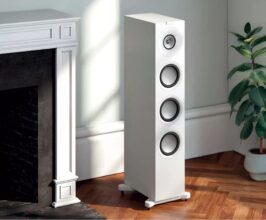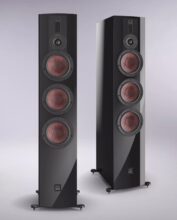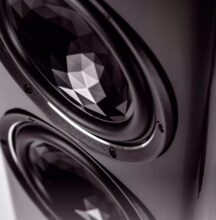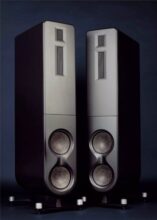Ps audio aspen fr30 review
Last year, PS Audio celebrated its 50th anniversary. But the company has even more reasons to celebrate. Two of them are currently in the STEREO listening room: PS Audio Aspen FR30.
Text: Tom Frantzen
They arrived as announced. Still, the four large packages weighing well over 200 kilograms were more than we expected. The Aspen FR30 is here—the flagship loudspeaker from PS Audio in Boulder, Colorado. Delivered by freight to impress us. Our intense curiosity helped during setup. The four boxes were quickly forgotten as the massive bass cabinets were connected to the mid-treble units. While the Aspens are given several days to break in, we shed light on their long and dramatic development story.
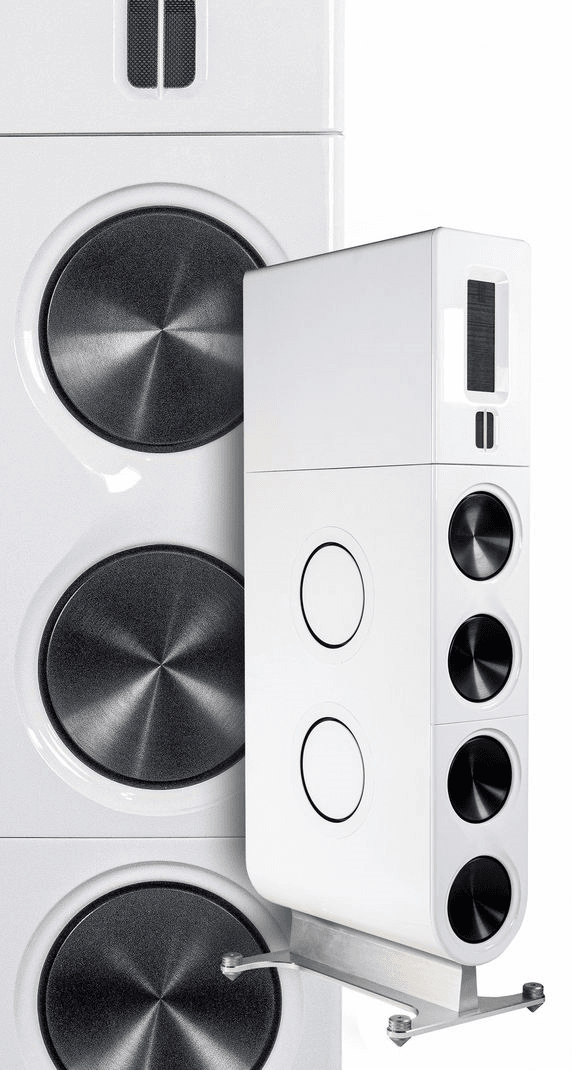
Aiming for the Best
At the beginning was the Infinity Reference Standard, created around 1979 by Arnie Nudell. Anyone who has been involved with hi-fi—and especially high end—for a long time is likely to feel a respectful shiver at that name. As tall as a person, four-part, with two wood-paneled mid/high columns and partially active bass towers, as heavy as a mid-size car—and when they are finally set up and optimally positioned, even huge rooms feel much smaller. A monumental loudspeaker. They are anything but easy to drive. But anyone who has ever heard them is deeply impressed.
The author of these lines has actually experienced several of Nudell’s creations live in action—from Genesis to various Infinity Reference Standard models (2.5, 4.5 and IRS V). In particular, Infinity’s all-time flagship, the uncompromising line-source IRS V that effortlessly fills a large room acoustically, left a lasting impression.
PS Audio CEO Paul McGowan felt the same. For years he searched for a good pair for PS Audio’s headquarters in Boulder, carefully restored them—meticulously documented—to peak condition, tuned them together with Arnie Nudell, Bascom H. King and PS Audio engineer Chris Brunhaver with better crossovers, bass drivers and amplifiers, and used them as a technical reference. He even had a custom listening room essentially built around them.
Nothing less than that became the benchmark for future PS Audio loudspeakers. The tuned IRS had to be matched, if not surpassed. In the autumn of his engineering life, Paul’s lifelong friend and business partner at Genesis, Arnie Nudell, wanted to push this once again. Sadly, he did not live to see the premiere of the PS Audio Aspen FR30.
A Completely New Path
The goal with this loudspeaker was to realize transducers using the latest technologies, with far more room-friendly dimensions and at still (relatively) down-to-earth prices, that could take on the legend of the IRS. Until then PS Audio had “only” appeared with electronics—phono pres, DACs, amplifier technology and, above all, uncompromising power conditioners—and had made a very positive impression. STEREO also visited the company in the U.S. in 2009 and reported on it.
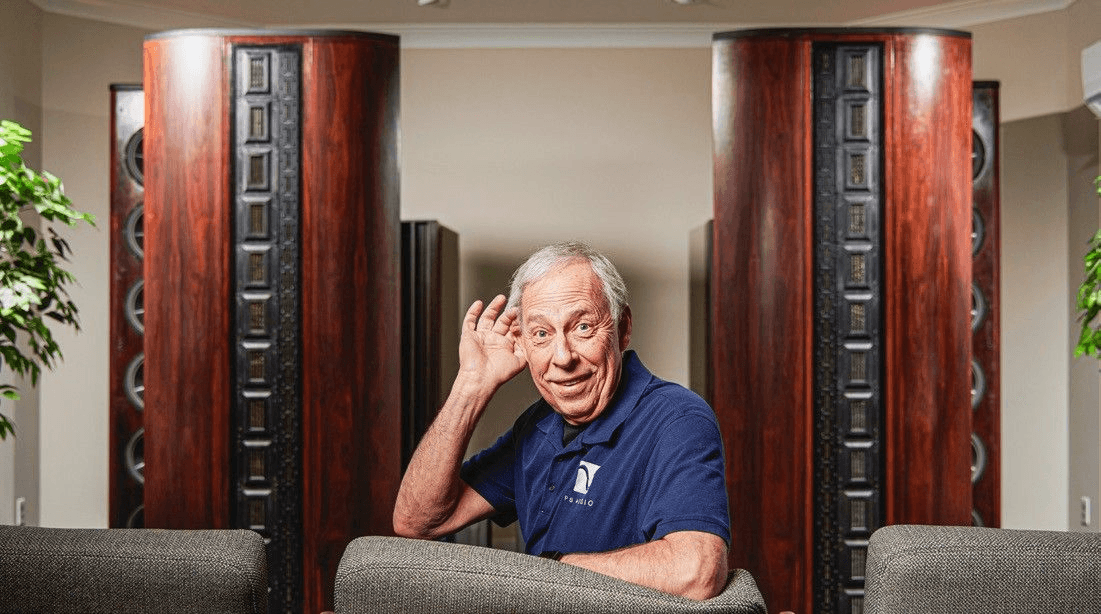
Paul McGowan, charismatic PS Audio founder, is a no-compromise audiophile (the “IRS” in the background). He assembled top-tier talent to realize “his” loudspeakers.
Veterans on the Sales Side
Interestingly, alongside PS Audio’s long-time German distributor Jürgen Sachweh (HiFi2die4), another industry veteran is involved on the distribution side: none other than Stefan Splawski, who for more than 25 years was significantly and successfully responsible in Germany for brands such as B&W, as well as Rotel, Classé, Marantz and Denon. Since this year he has teamed up with Jürgen Sachweh to push the renowned American brands JL Audio and PS Audio far forward in this market—to where he believes they belong.
Back to the FR30. Paul McGowan and Arnie Nudell first searched the market for suitable drivers to adequately replace the sensational EMIMs and EMITs of the Infinity era. These needed to combine effortless detail with a certain robustness and authority. But nothing suitable was found. So they developed their own. It quickly became clear that only magnetostats were still an option, where an extremely light and therefore fast diaphragm oscillates in a magnetic field between two strong poles. They chose a low-mass Teonex film diaphragm and expensive neodymium as the best magnetic material for both the 10-inch midrange and the 2.5-inch tweeter. In particular, the uniquely elaborate midrange—right down to the production tooling—was designed to cover the musically most important band on its own.
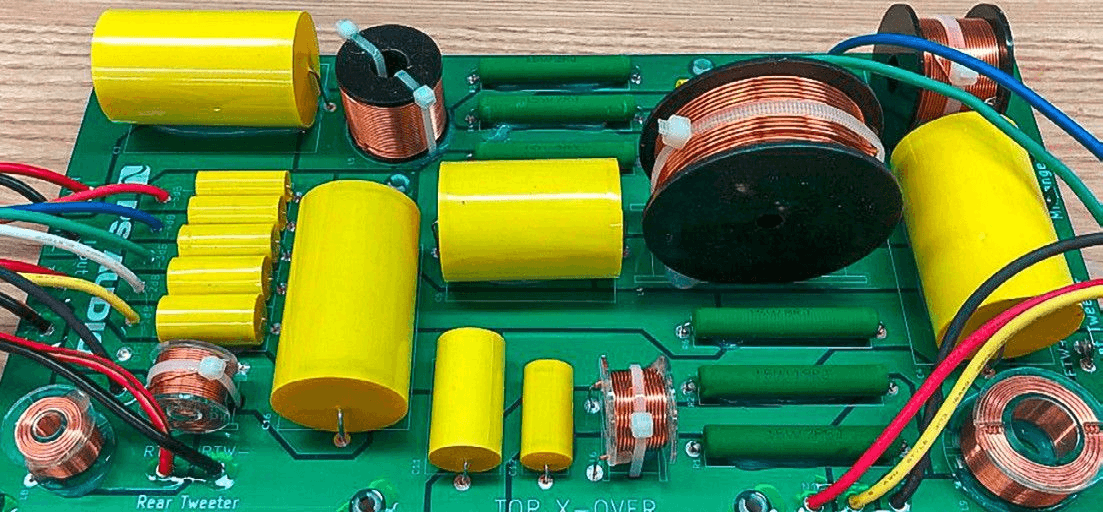
The separate mid/treble section of the steep Linkwitz–Riley crossover ensures seamless transmission of the midrange between 400 and 2,500 Hz.
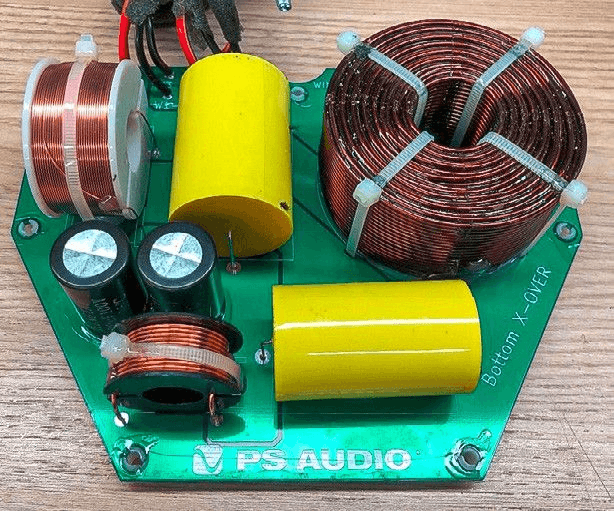
At 400 Hz, the Aspen’s low-frequency systems couple deeply to the midrange.
When Arnie passed away a few years ago, a highly capable developer in his mid-thirties, Chris Brunhaver—who uses the most modern research and methods—seamlessly took over leadership of the still early-stage project whose completion was so dear to company head Paul McGowan.
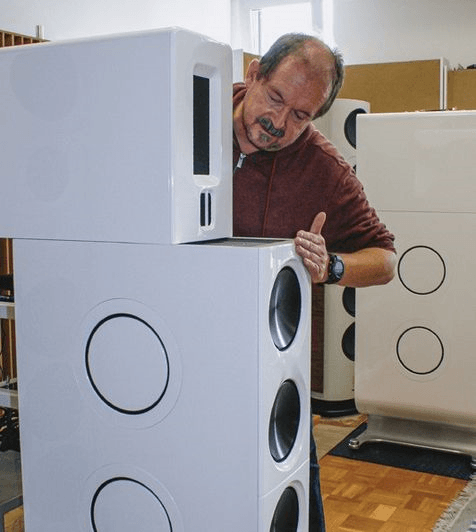
The editor assembling the mid/treble section of the PS Audio Aspen FR30.
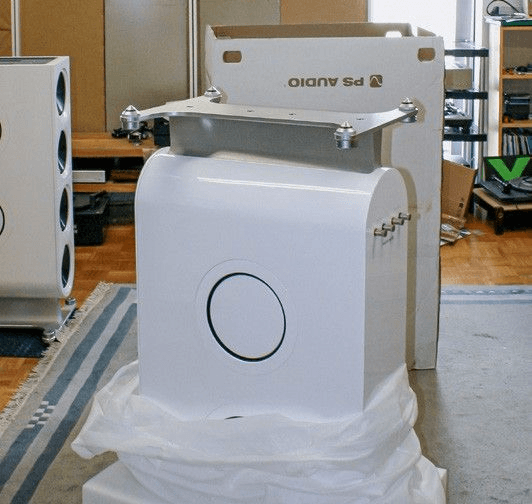
“Speaker load” at its best: roughly 250 kilograms of U.S. transducer, pallet and all.
Bass-Powered Sculpture
PS Audio lives up to the American reputation for enormous bass. That’s unmistakable in the tuttis of Dvořák’s “Symphony No. 9” as well as on Pink Floyd’s “The Wall.” For the low-frequency department, they devised a design of four long-throw, extremely fast 8-inch (20 cm) aluminum-cone woofers mounted in sturdy cast frames. These are supported laterally by a total of four passive radiators—one pair on each side of the cabinet. The extremely rigid, braced MDF enclosure isn’t open like a bass-reflex system, but the tuning of the passive membranes can be set to a low frequency.
Thus, this construction—comparable to bass-reflex and enabling rich deep bass despite still manageable dimensions—also unites advantages of a sealed box, such as the shock-absorber-like stiffness of the air cushion inside, to leverage precision and transient accuracy without port noise. The IRS’s semi-active layout was dropped; the FR30 should be easy to drive. As a side effect, more room-friendly dimensions are possible. Yet headroom is still formidable, as hinted by the unusually low distortion across the entire spectrum, including the bass, measured in the lab. Clearly, some things were deliberately over-engineered to always keep reserves.
The four 8-inchers add their cone area without becoming as sluggish as larger single drivers or forcing a broad baffle. They couple very well to the magnetostats and also work with less excursion than one large woofer, which prevents distortion. You hear after two bars that this does not come at the expense of bass power. The cleanliness of the bass is astonishing. Also contributing is the slender base, which decouples from the floor and couples via stable outriggers and spikes. It gives the loudspeaker a sculptural lightness. Most will immediately recognize the PS Audio Aspen as a loudspeaker—but not everyone at a glance.
Stunning Result
The FR30’s two-part crossover, like the cabinet, is particularly elaborate in that it is fully phase-corrected—i.e., time-aligned. It’s a 4th-order steep-slope filter, named after designers Linkwitz and Riley. The drivers’ operating bands are crossed at 400 and 2,500 Hz, achieving the goal of seamless midrange transmission in between.
You can also see the phase optimization in the step response, where the drivers follow each other almost synchronously, even if negligible ringing remains. Measurements show a fairly balanced frequency response with good depth (38 Hz at −3 dB) and an average sensitivity of 85 dB at 2.83 V input. Unlike some Infinity speakers, the impedance is not only uncritical but also very linear and should “please” any amplifier, including tubes and Class D. Off-axis, the treble falls off, so it’s best to toe-in the PS Audio slightly to avoid that at the listening seat.
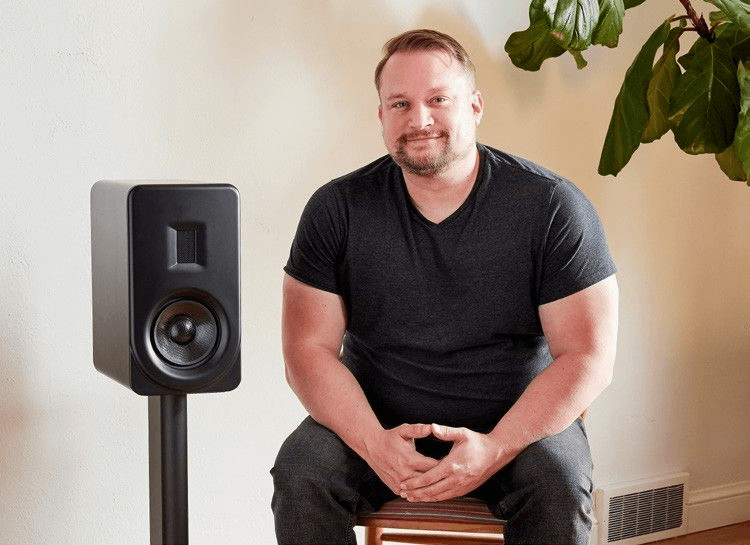
Strong characters: Chief engineer Chris Brunhaver next to the smallest PS Audio, the Aspen FR5.
A Sonic Heavyweight
Each FR30 weighs just under 105 kilograms—a true heavyweight—sensibly designed in two parts for easier transport and assembly in the listening room. A very clever decision. The bass section sits in the tall base, while the mid/treble section with the magnetostats—comparable in size to a typical compact speaker—is precisely mounted on top via a sophisticated metal rail and connected with high-quality cable. The main terminal is in the lower part of the Aspen FR30 and also allows bi-wiring and bi-amping.
The FR30 is—at least if you’re similarly sturdy—still a manageable floorstander, thankfully far removed from the excess of an Infinity Reference Standard that hovered as a “godfather” over this project. On the rear of the FR30 there is another magnetostatic tweeter for “ambience,” which deliberately involves the room and, via reflected sound, adds a kind of spatial “icing.” Level and distance from the wall can be adjusted. In STEREO’s large listening room this was indeed better “on,” as long as intensity wasn’t overdone. With the “Far” setting—the rear wall was about 130 cm away—and level 1 or 2, the small rear-firing treble addition was pleasant, while level 3 already gave the sound an “aura” that was a bit too artificial for our taste. With trained ears, you clearly hear that.
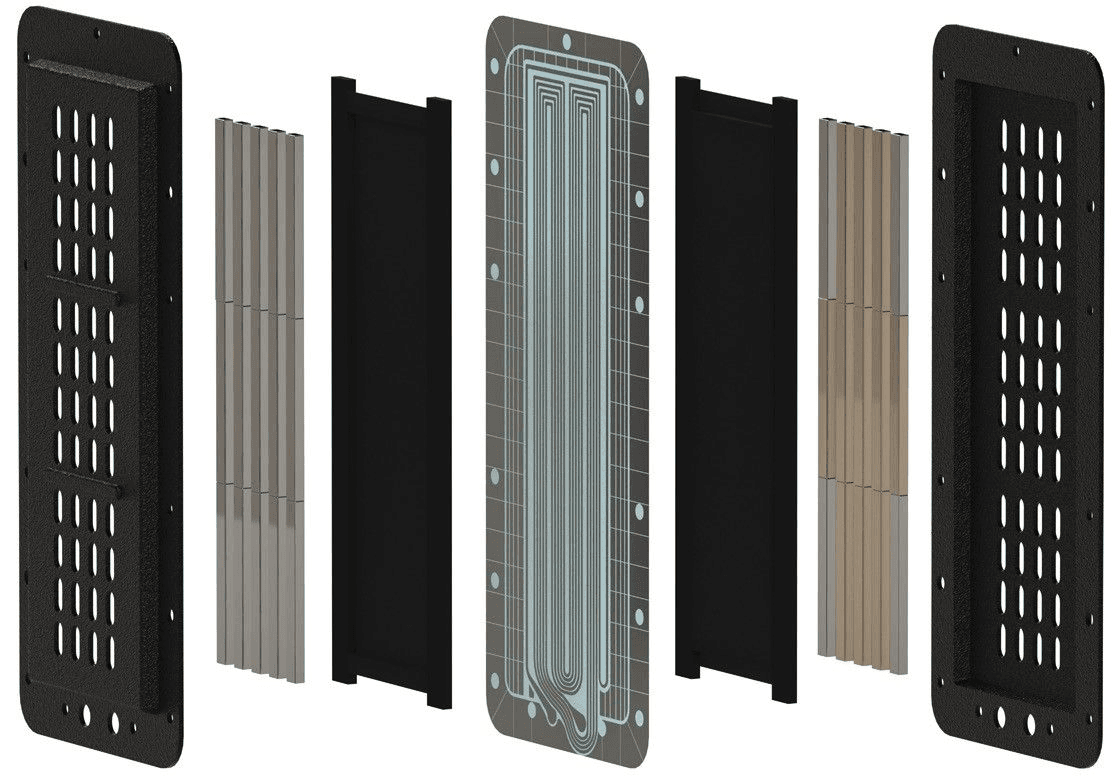
For the diagonally 10-inch magnetostat with neodymium motor and Teonex film diaphragm—shown here in parts—new, proprietary tooling was necessary.
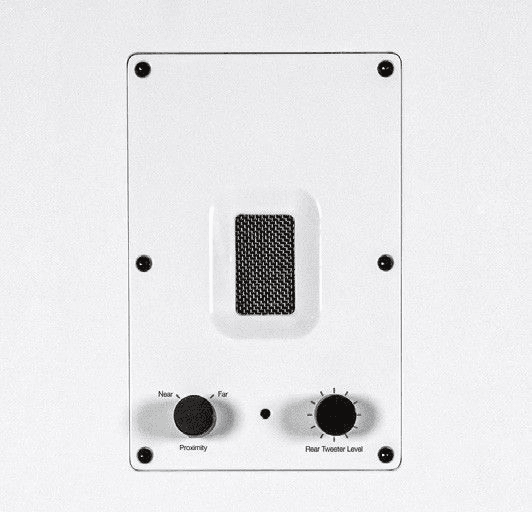
A second 2.5-inch tweeter radiates to the rear—adjustable—for more spaciousness.
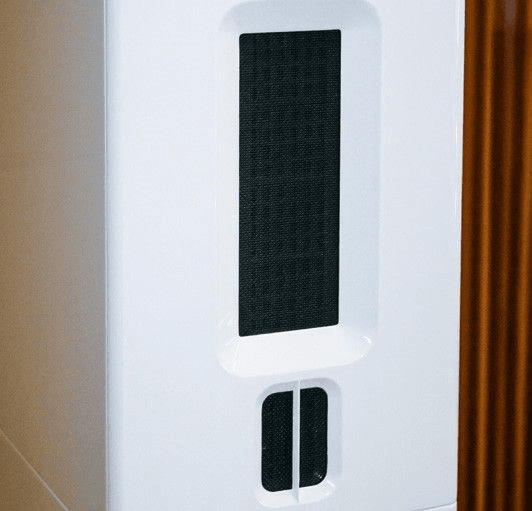
The magnetostatic mid/treble section is a master of fine resolution and speed.
A Singular Experience
The PS Audio projects a wide and deep stage, filled with vibrant life, extending even above the speaker height. Resolution across the band seems very fine; everything feels effortlessly delivered—even at levels that could earn us trouble with building management. No strain, zero compression, nothing. Even the rich textures in the very lowest bass come across so easily and authoritatively that it’s a joy to listen to stacks of CDs with these test candidates, driven by the Accustic Arts amplifier combo and fed by a T+A MP 3100 HV. A loudspeaker is usually a compromise compared to a live event; with large transducers that gap nearly vanishes.
The PS Audio practically disappears, and despite all its authenticity and speed—whether with funky plucked metal strings or monstrous kick-drum impulses—it sounds merciless, uncompressed, utterly real. Tori Amos at the piano is virtually projected into the room. Stunningly good. We often hear excellent music here—that much is a given. But this is something else. The top league. The large PS Audio is reportedly selling well in specialty retail. Those who hear it want it. Sometimes it’s that simple.
In principle, you should of course grant the FR30 an adequate amplifier system that is fast and strong so there’s no unnecessary limitation on the amp side. Then the FR30—costing about $46,740—will undoubtedly have to be counted among the very best loudspeaker systems in the world.
The series also includes three other models. The Aspen FR10 is designed for smaller rooms and, at around $15,191 per pair, costs roughly a third of the flagship. The middle model, FR20, is about $31,550, and the compact FR5 is around $6,193 per pair.
Old Friends and Modern Times
Shortly after completing the Aspen FR30, Paul McGowan sold PS Audio’s tuned—and thus unique and best—Infinity Reference Standard V to a hi-fi enthusiast who operates a loudspeaker museum, for a high five-figure dollar price, because he considers the FR30 the “significantly better” loudspeaker in most essential respects. So there you have it.
PS Audio’s flagship goes “over the counter” for around $46,740 per pair, whether you choose high-gloss black or pearl white. The lacquer is applied ten times and looks exceptionally classy.
We’d love to write “Here to stay” now. Sadly, we have to send the PS Audio Aspens back—and certainly not because the author wants that. On the contrary. To him, this is one of the best transducers on the planet—and undoubtedly one of the best he has ever heard.
TEST EQUIPMENT
CD player: T+A MP 3100 HV
Integrated amplifier: Accustic Arts Power 3, Gryphon Diablo 333, Symphonic Line RG 14 Edition Mk 5S
Preamplifier: Accustic Arts Preamp V
Power amplifier: Accustic Arts Amp VI
Loudspeakers: B&W 801 D4, Canton Reference Alpha 1
Cables: Audioquest, In-Akustik, Cardas, Silent Wire, Supra
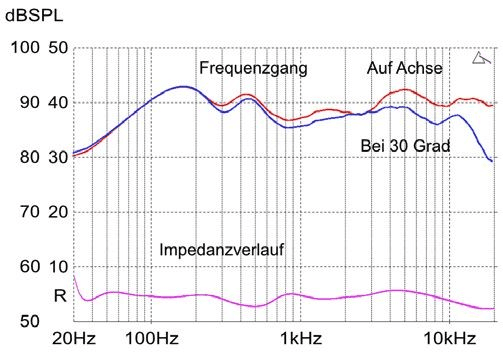
Balanced frequency response except for the deliberately pleasant restraint in the mids.
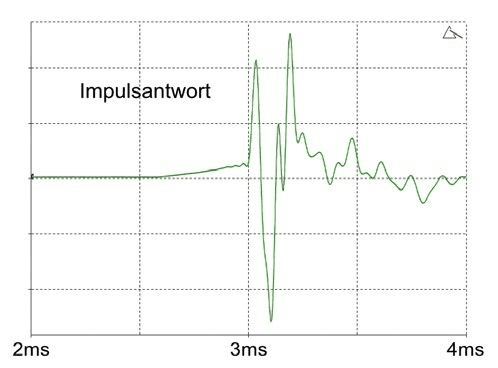
The step response shows the unusually strong synchrony of the drivers that was aimed for.
PS Audio Aspen FR30 – Test Result Summary
Product / Price Class
Floorstanding speaker (passive) / $23,370 – $46,740
Website
www.psaudio.com
Price
$46,740
Dimensions (W × H × D)
40.5 × 153 × 65 cm
Weight
104.5 kg each
Distributor (Germany)
hifi2die4
Contact
+49 7175 909032
Design Principle
Dynamic, magnetostats, 3-way, passive radiators, plus ambience tweeter
Terminal
Bi-Wire
Placement Recommendation
Free standing, slightly toed-in
Sound (60%)
Overall rating: Very good (1.2) → 8.8 / 10
Sound quality: High resolution and plasticity, natural mids, powerful bass, excellent micro- and macro-dynamics
Measurements (15%)
Overall rating: 1.9 → 8.1 / 10
Frequency response: Good
Sensitivity: Moderate (85 dB)
Impulse response: Good
Minimum impedance: Very good (3.5 Ohm @ 500 Hz)
Distortion at 63 Hz / 3 kHz / 10 kHz: Good (0.34% / 0.08% / 0.13%)
Amplifier compatibility: Good
Features (25%)
Overall rating: 2.2 → 7.8 / 10
Placement: Good
Manual quality: Good
First setup: Good
Tone control: Yes
Finish options: Black, White (2 versions)
Accessories: Cover, foam plugs
Build quality & finish: Very good
Upgradeable: No
Warranty: 5 years
Final Grade
1.6 → 8.4 / 10 (Very Good)
In short: The PS Audio Aspen FR30 is rated 8.4/10 overall—strongest in sound quality (8.8/10), very solid in measurements (8.1/10), and respectable in features (7.8/10).
Is the Aspen FR30 a sweet spot speaker?
Can the sweet spot on an FR30 loudspeaker be wide enough for more than one person to enjoy? And, the Audiophile's Guide ...


